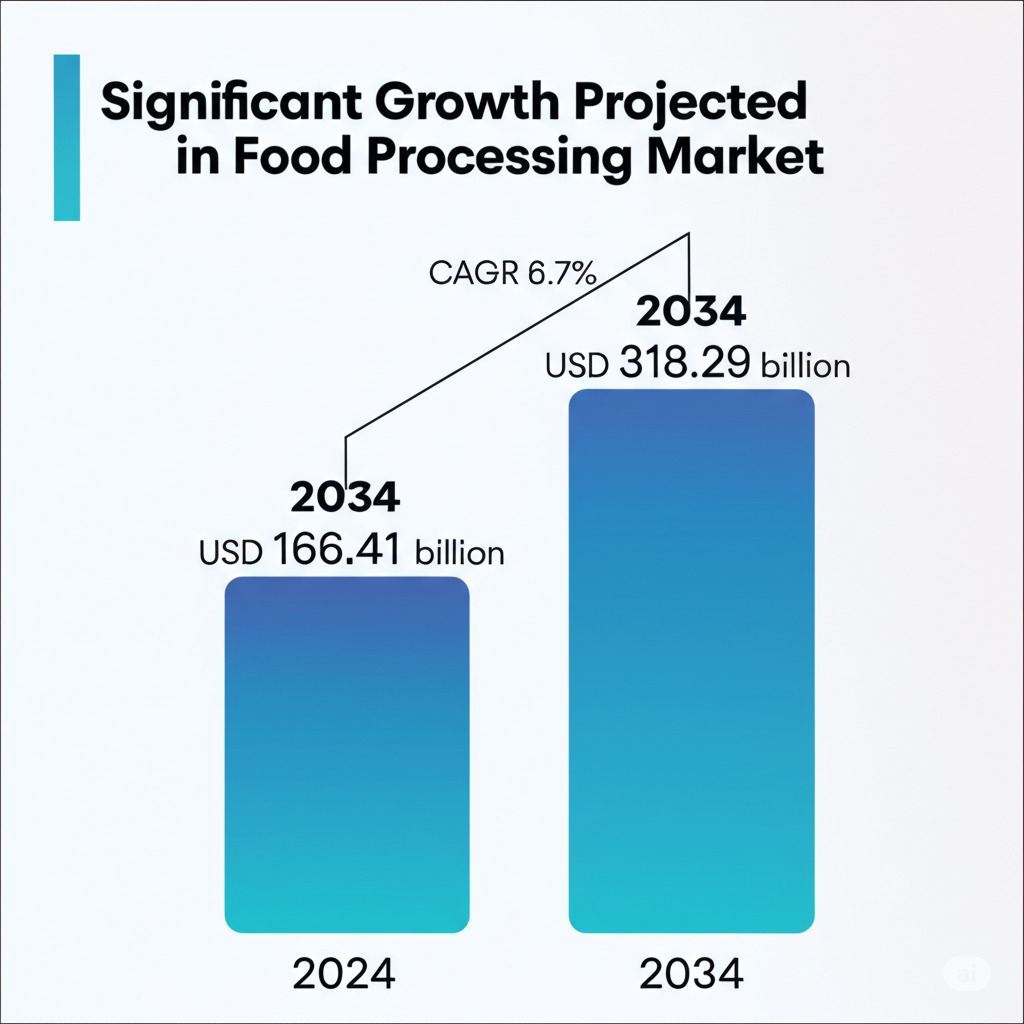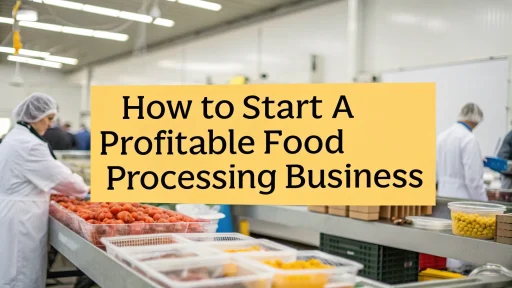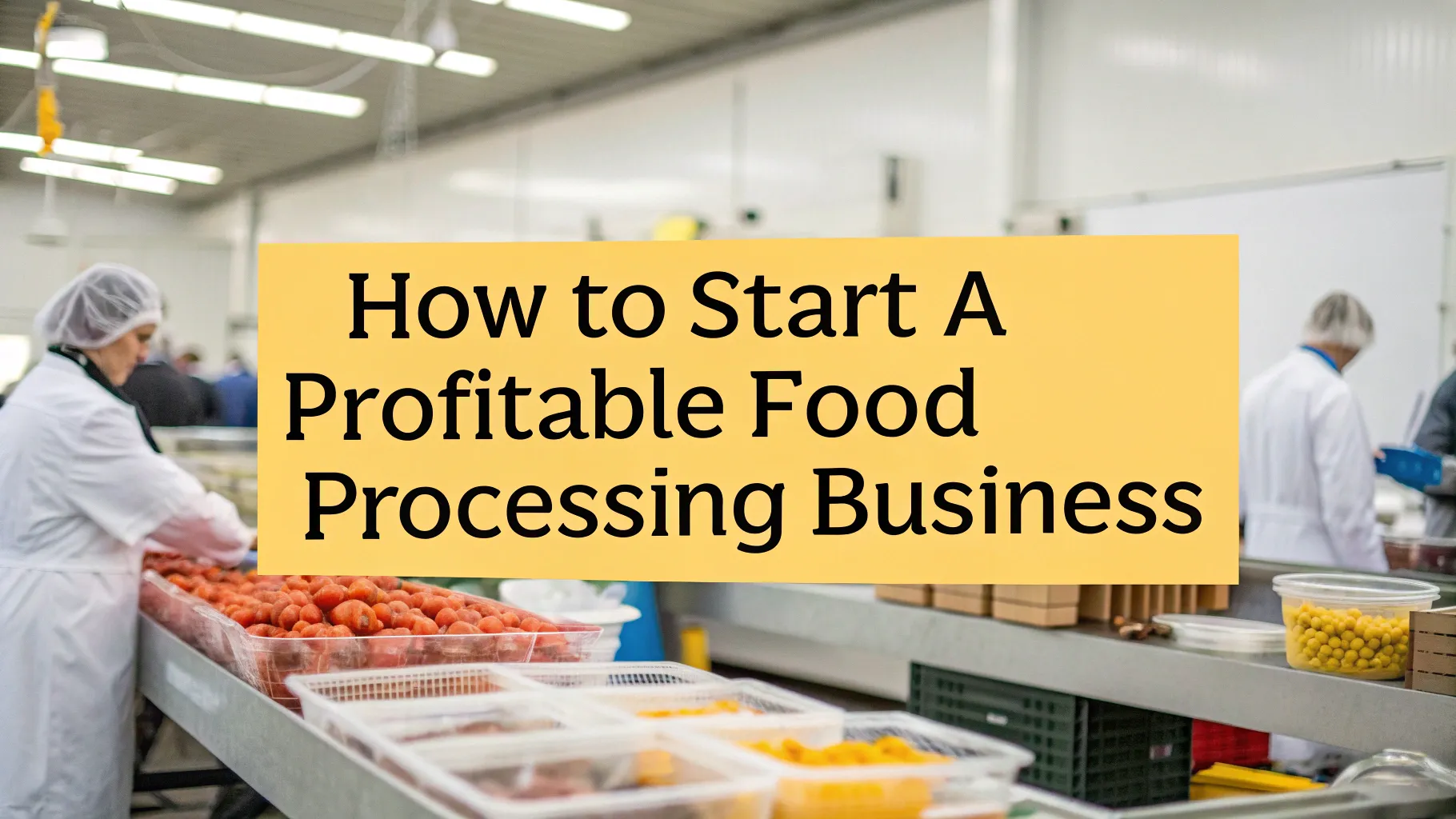Food processing is a sector that is dynamic and evolving rapidly, and offers many opportunities to aspiring entrepreneurs. Food processing Business is the process of transforming agricultural raw materials into attractive and consumable products. This involves various essential processes such as cleaning, sorting and processing, packaging and distribution.
This comprehensive guide provides you with a detailed road map on how to launch a profitable food processing business. It covers vital market trends and manufacturing processes as well as essential considerations that will help you achieve success.
Market Overview and Growth Prospects
Global food processing is growing rapidly, driven by changing consumer lifestyles and increased disposable incomes. New companies need to understand the scope of the market.
Market Size and Forecast
The food processing industry is growing rapidly. Here is a summary of the market size and forecast:
| Year | Market Size (USD billion) | Projected Size (USD Billion) | CAGR (%) | Source |
| 2024 | 166.41 | 318.29 | 6.7% | Estimated by 2034 |
| 2024 | 170.25 | 273.39 | 7.00% | Estimated by 2031 |
| 2024 | 162.92 | 299.77 | 7.01% | Estimated by 2033 |
| 2024 | 166.38 | 277.44 | 6.60% | Estimated by 2031 |
These data highlight the sector’s appeal for new business ventures and investments.

For more detailed information, view our Handbooks on Food Processing, Food Industry, Agriculture, Agro Processing
Key growth drivers
The market is growing due to several factors:
- Convenience foods are in high demand due to the fast-paced lives of today and the increasing urbanization. The consumer wants packaged, ready-to-eat, and easy-to-prepare options.
- As the middle class expands, especially in emerging economies and other developing countries, consumer awareness about food quality and safety increases, leading to increased spending on convenience foods and processed foods.
- Sustainable packaging and processing techniques are becoming more popular as environmental concerns gain in importance. Businesses focus on reducing energy consumption and carbon emissions, as well as reducing waste.
Regional Insights
- Food processing is expected to grow at the fastest rate in Asia-Pacific, thanks to rising incomes and an expanding working class.
- North America was dominant in the food processing industry in 2024. This position was influenced by consumer preference and technological advancement. This region continues to be a major player in the food processing market, driving trends and innovation.
Related: Launch Your Profitable Food Processing Business
Find Profitable Food Processing Business Ideas
Food processing offers a wide range of business opportunities. Here are some ideas with a high profit potential. A bakery can be a profitable venture due to the growing demand for bakery products that are ready-to-eat and packaged in attractive packaging. Dairy product manufacturing is another promising sector. This includes dairy staples such as butter and cheese as well as innovative, plant-based alternatives for health-conscious consumers.
Fruit and vegetable processing is also rewarding. Fresh produce can be transformed into jams and purees as well as powders, dehydrated products, and powdered drinks. These are all highly demanded on the market. Another important area is grain milling and flour manufacturing. This involves milling grains like wheat, millet, maize and other grains into different types of flour, both for household and commercial purposes.
Convenience foods such as packaged snacks and ready-to-eat meals continue to grow due to busy lifestyles. Plant-based foods are a sector that is rapidly growing, and there are many opportunities to produce plant-based alternatives for meat and dairy to satisfy the vegan and vegetarian market.
Manufacturing Process Overview
Food Processing manufacturing includes several stages that are essential to the overall quality, safety and appeal of the product.
- Source Raw Materials: A successful food processing company is built on obtaining high-quality materials. Selecting reliable suppliers and managing crop cultivation is important.
- Pre-Processing : Prepare raw materials to be further processed by cleaning thoroughly, sorting and using various preparation methods. This can include washing, peeling and slicing as well as removing unwanted components.
- Processing: The transformation of pre-processed material into the desired product by using the appropriate technique. The most common methods are cooking, baking and freezing.
- Packaging: The process of enclosing a finished product into suitable containers in order to prevent contamination, prolong shelf life and inform the consumer. Packaging materials should be of food grade and conform to regulations.
- Quality Control: Constantly ensure that the product meets regulatory, safety and quality standards by testing regularly for taste, texture and nutritional content.
- Distribution: Distribute the packaged food products to retailers, wholesalers or directly to consumers. For timely delivery and to maintain product freshness, efficient logistics and supply-chain management is essential.
The Key Techniques and Technologies in Food Processing
Food processing is changing as a result of several innovative technologies and techniques. High-pressure processing is a nonthermal preservation technique that improves food safety and preserves the original taste. Modified Atmosphere Packaging extends shelf life by changing the composition of the atmosphere inside the package. This slows down the spoilage of food. Pulsed Electric Fields are an advanced preservation method that uses short bursts to maintain food’s nutritional value and taste.
Robotics and automation are being increasingly integrated in food processing. This helps to improve efficiency, reduce waste and enhance food safety. The 3D printing technology allows the creation of personalized food products that are tailored to meet individual nutritional needs. Blockchain technology provides real-time information about the journey of a product from the farm to a consumer’s plate, increasing transparency and trust.
Related: Top 10 Government Schemes for Food Processing Startups
Food Processing Industry Challenges
A food processing company faces a number of complex challenges. The rising costs of operations, such as the cost of energy, raw materials and transportation, may have a significant impact on profitability. Another obstacle to maintaining consistency is labor shortages. This is especially true in regions where there’s a lot of competition for hospitality workers.
The complex regulations governing food safety and labeling can be costly and time-consuming. They require meticulous attention to details. During global disruptions, supply chain issues such as ensuring high-quality ingredients and a constant supply can be a challenge. In addition, the industry faces fierce competition that requires continuous innovation and differentiation in order to be competitive.
Sustainability is becoming a more important factor. It requires the adoption of sustainable methods to reduce environmental impact and to appeal to environmentally-conscious consumers. It is important to prevent cross-contamination in order to maintain food safety and integrity. Flexibility and responsiveness are required to adapt to changing consumer preferences, such as the growing demand for non-GMO and plant-based organic products.
For more information check out this video
Tips for Success
For the food industry to succeed, it is important to conduct thorough market research. This will help you understand the market demand for your products, identify your target audience, and analyze your competition. A comprehensive business plan outlining your goals, strategies and financial projections will also help guide your operations.
To build consumer trust, it is essential to prioritize food safety through the implementation of strict quality control and adherence to all relevant food regulations. Adopting advanced food processing technologies can increase efficiency, lower costs and improve product quality. By implementing sustainable practices, you can reduce waste, conserve resources and appeal to environmentally-conscious consumers.
Find Best Idea for Yourself With our Startup Selector Tool
Niir Project Consultancy Services
Niir Project Consultancy Services offers extensive assistance to entrepreneurs who are navigating the complexities involved in starting a business. NPCS produces Market Surveys and Detailed Techno Economic Feasibility Reports that provide valuable insights into market potential, manufacturing processes and financial aspects for various food processing ventures. These reports provide detailed information about manufacturing processes, raw materials, plant layout and comprehensive financials to enable entrepreneurs to make informed decisions. NPCS is a tool that helps entrepreneurs to assess the feasibility of establishing new businesses or industries, ensuring their success.
The conclusion of the article is:
A profitable food processing venture requires meticulous planning, an in-depth understanding of current market trends, as well as a commitment to safety and quality. Entrepreneurs can take advantage of the growth opportunities in the food processing industry by identifying and implementing a viable business concept, using efficient and sustainable manufacturing methods, and remaining responsive to changing trends. With expert resources such as NPCS backing them, aspiring food producers can turn their entrepreneurial visions and ideas into a tangible reality, contributing to the ever-evolving food industry.







